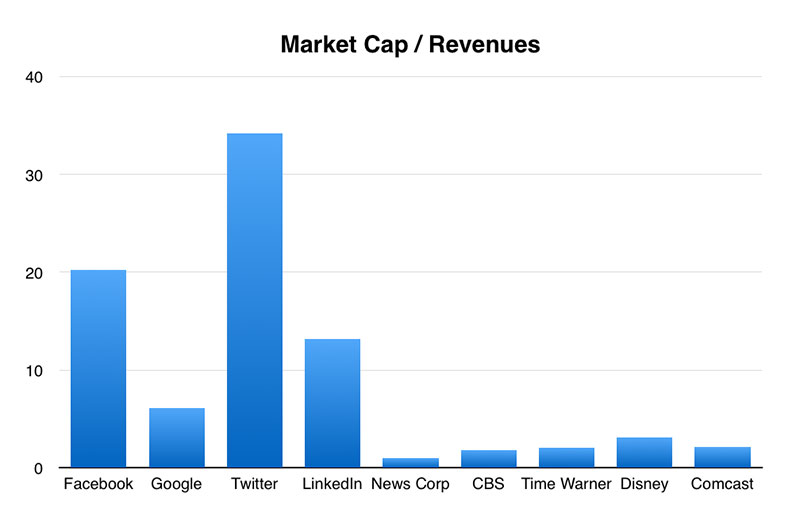Many of us have a second job. We steal time from our family, from our employer and from our hobbies in order to work on it. It doesn’t pay anything, in spite of the tremendous amounts of creativity and time we invest in it. Somehow, we convince ourselves it’s worth doing (perhaps because we know everyone else is doing it too).
I’m talking about your second job as a Facebook user. Or maybe it’s a Twitter, Google+ or LinkedIn contributor. I’ll concentrate on Facebook though, since so many of us use it. According to Mark Zuckerberg, “people on Facebook in the US spend around 40 minutes each day using our service.” So, it’s really just a part-time job. We do it for a little over four and a half hours a week, on average; some of us obviously much more, and some of us much less.
We don’t get paid for these hours, so really it’s more of a volunteer gig. Except that, in this case, we’re not really doing it for a charitable, nonprofit organization, but for an entity whose net profits were $1.5 billion last year and whose revenues are now growing at around 55% a year.
The Exchange of Value on Facebook
But we all get something from all that time we invest in Facebook. There’s value there, or we wouldn’t be doing it. We get to stay up on what our friends are up to and keep them informed on our latest puppies, trips, anniversaries and even our little rants and raves over the news and other stuff. Despite how easy it is to make fun of our addiction and our time spent there, it’s actually a very valuable service.
The same could be argued for watching TV – and we still actually spend a lot more time there. As hard as it is for me to believe, Americans spend some five hours a day watching TV, on average.
With TV, we play a critical role as watchers of the stream of content and the advertising neatly tucked between the crevices of what we actually want to see. Without our eyeballs, there’s no advertising revenues. As media consumers, we play a critical role the value proposition to the actual customers: – the advertisers.
This is true with Facebook too, but there’s also a critical difference because, with Facebook, I’m not just consuming the media, I’m also creating it. In fact, without you, me and the billion-plus other nodes in that network, nothing would flow through it.
I’m telling you this like it’s news or something. But it’s not, of course. We all know that it’s ourcontent that makes Facebook, LinkedIn, Google+ and Twitter actually work, but somehow, we’ve convinced ourselves that contributing all this time and energy for free is absolutely normal.
But is it?
Facebook Users: the Value of Volunteer Labor
When you look at the market capitalization of media firms, you see that new media is valued much more highly than old media. Take the total value of outstanding shares of a company and divide it by its revenues, and you end up with a ratio that can help show the market’s expectations of these stocks (I use revenues versus earnings because LinkedIn and Twitter still have negative earnings, and because revenues are less easily manipulated than earnings).
Most of what this chart shows is what you’d expect to see in any comparison of growth stocks vs. more mature stocks: the market anticipates growth into the price of the stock, and the law of numbers dictates that it’s easier to grow from a small number than a larger one.
And yet, what if there were a class of media properties that were just intrinsically more profitable than others because of the way that they were built? What if a media firm designed itself to no longer rely on paid employees to produce content? What if it could automate the outsourcing of this work, not to developing economies, but to end users?
A firm like this would still have employees, but most of them – certainly the highest paid ones – would be extremely technical software engineers charged with building the technological platforms needed to enable end users to contribute free content.
A company like this could be extremely profitable, especially if it built sufficient critical mass to be the go-to place for end users to contribute content and know it would be seen by others. This is exactly what we’re seeing with our newly emerging media titans, and it’s a bigger pattern of technology: displacing jobs, increasing profits. I cover this shift in media in more detail in “A Pattern Language for New Media.”
It’s Our Decision
This isn’t just about Facebook social sharing. The Huffington Post operates a version of this, using bloggers for its workforce, and now LinkedIn has perfected that approach with its new, and fast-growing, bureau of Long-Form Posts writers, a number of whom are quite good.
______________________________________________________
About the Author
This article was written by Gideon Rosenblatt of The Vital Edge. Gideon ran an innovative social enterprise called Groundwire for nine years. He worked at Microsoft for ten years in marketing and product development, and created CarPoint, one of the world’s first large-scale e-commerce websites in 1996. The Vital Edge explores the human experience in an era of machine intelligence.






























